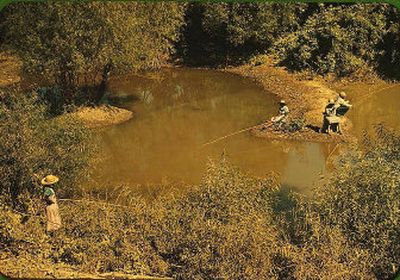Different dimension

WASHINGTON – In the photograph, they are fishing in a small, muddy pond, cane poles reaching over the water. A man and three women. Somewhere around 1939, near a town in the Mississippi Delta called Belzoni (pronounced BELL-zone-uh).
You can look at this rural idyll for quite some time before you notice not only the reflections in the water, but that the pale blue of two women’s dresses is also held in the brown, watery stillness.
It’s a startling moment, of which there are many in “Bound for Glory: America in Color, 1939-1943,” an exhibition of rare Depression-era color photographs at the Library of Congress. The 70-image exhibit, culled from the work of some of the best photographers of the era, runs through Nov. 26 in the Great Hall of the Thomas Jefferson Building.
The black-and-white images taken by Farm Security Administration photographers during the Depression and its immediate aftermath are, of course, some of the most famous photographs in and of American history. The fact that some of these same photographers – Marion Post Wolcott, Russell Lee, John Vachon – loaded newfangled Kodachrome film into their cameras is at once a technical curiosity and a cultural revelation.
Color film had been introduced only a few years earlier, and was only just beginning to give people the idea that their world could be duplicated: not just the shapes and shadows, but the colors that filled their everyday lives. Today, the photographs are some of the earliest images of the dyes used in women’s dresses in rural Mississippi, the faded red of a barn in Connecticut, or the twist of blue in a homesteader’s dungarees in Pie Town, N.M., in 1940.
“I’ve spent 30 years looking at black-and-white images of this era, and they’re full of meaning, but the color ones have a different dimension,” says Beverly Brannan, a curator of photography at the Library of Congress. “This is how the world actually looked.”
And, as digitally reproduced in these images, how radiant the world was! Even then, even before the mass-produced, computer-enhanced world of Pixar.
In the first part of the exhibit, is one of the most famous pictures, a Jack Delano shot of the 1941 Vermont state fair. Five girls, apparently sisters, gaze in different directions. Their simple cotton dresses are varying shades of faded red, with white Peter Pan collars and little blue kerchiefs dangling from the neck. Now look to the background of the picture, at the blood-red ticket booth – the factory-made depth of red looks liquid, ready to melt. The contrast in color not only gives the picture its immediacy and its visually arresting element, but it also reveals the age, the wrinkles, the hand-me-down aspect of the girl’s dresses. It suggests the upper edge of poverty, the lower edge of corporate profit. A passing feeling of melancholy.
Or consider the color in Wolcott’s picture of the fisher-folk. The color doesn’t make it a better photograph – no one argues that these pictures are more profound than their monochrome counterparts – but it adds information from an era that we previously pictured in shades of gray.
“I look at them as cultural artifacts,” says Ralph Eubanks, director of publications at the Library of Congress, who oversaw the publication of the “Bound for Glory” book, produced last year. “Everyone thinks the Depression happened in black-and-white. You know that’s not right, but seeing it here is still startling.”
Photographers were still finding their way with the use of the technology but sometimes they hit it just right, with the attention to detail that resonates through the years.
There is another Delano image here from 1943, the war in full swing. He’s in Clinton, Iowa. Women in overalls, caps and goggles are eating from their lunch buckets at the Chicago and North Western Railroad. Most are older, pulling sandwiches from waxed paper wrappings.
One woman appears a bit younger. Her hair is wrapped in a dime-store red bandanna. She wears overalls and a work shirt, a tough-looking dame. But notice: Her fingernails are painted a brilliant, matching red, and her cheeks, there on the rail yard, have the unmistakable hint of rouge. You wonder if she applied that makeup in the dark before she left the house; if there were children there, or maybe only the memory of a man now on the far side of the ocean. You can’t help but wonder if the tenderness implied in those feminine gestures survived the war and the rail yard, and you find yourself hoping that the world turned out well for her.